Traditional Bolognese may be served over tagliatelle, but gnocchi Bolognese is currently my favorite comfort food. A rich, savory Bolognese sauce, simmering with a perfect blend of meats and vegetables, and toothsome, pillowy Gnocchi eager to soak in every ounce of flavor. It’s not just a delicious combination; it’s a warm hug in a bowl.
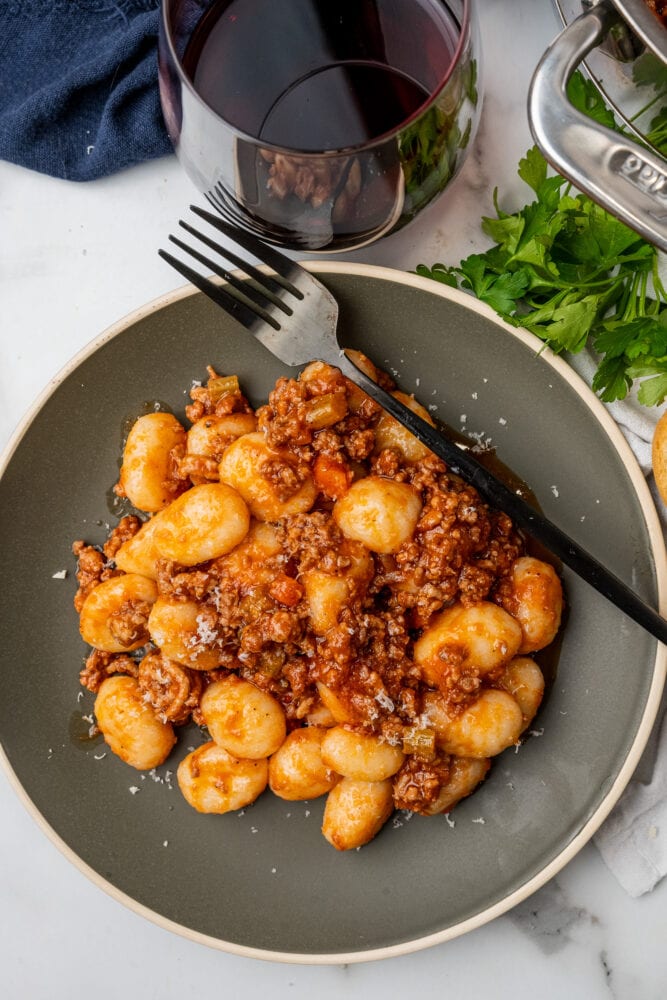
Bolognese brings a hearty, umami-packed punch to the table. The slow-cooked amalgamation of tomatoes, finely minced meat, and aromatic veggies creates a sauce that’s not just savory, but downright indulgent. My husband Pete could eat Bolognese sauce like a soup. And to be honest, I could too. And then there’s Gnocchi – those tender potato dumplings that are like little sponges, ready to absorb and enhance flavors.
What makes this duo of Bolognese and gnocchi so great is the sheer synergy of tastes and textures. The robust, meaty notes of Bolognese find their match in the soft, cloud-like texture of Gnocchi. As the sauce embraces each dumpling, it’s a flavor dance where each element contributes its unique melody, resulting in a dish that’s greater than the sum of its parts.
Ready to indulge in a hearty bowl of gnochhi Bolognese? Hit the “Jump To Recipe” button to get started, or scroll through below for some extra tips and tricks.
Bolognese: A Symphony of Flavors
Bolognese sauce, or “Ragù alla Bolognese,” is not just a sauce; it’s a culinary symphony that originated in the charming city of Bologna, Italy. It’s a slow-cooked masterpiece blending tomatoes, finely minced meat (a harmonious mix of beef, pork, and sausage), and a melody of aromatic vegetables. It’s a dish that transcends generations, a testament to Italian culinary heritage. I first learned to make a true Bolognese sauce while spending a summer staying in Bologna, Italy. Since then, I don’t usually deviate from the traditional Italian recipe. It’s simply perfect as it is.
How to Pronounce “Bolognese”: Embracing the Italian Rhythm
Before you embark on your culinary adventure, let’s tackle the linguistic challenge. Pronouncing “Bolognese” is an art in itself. It’s not “bowl-oh-nez,” that’s more of the French way. But rather, it’s a rhythmic “boh-lo-neh-zeh.” Now, you’re not just cooking; you’re conducting an Italian symphony. Truly, though, in Bologna they just call it ragu.
Adding Gnocchi To Bolognese
Now, potato gnocchi is originally from Northern Italy. So not too far from Bologna. So I think it is a good culinary pairing. The cooler climate in northern Italy was more conducive to growing potatoes instead of grains. It’s these starchy potatoes that contribute to the creation of a light, airy dough, giving gnocchi its characteristic soft, pillowy texture and a more pronounced potato flavor.
Ingredients For Gnocchi Bolognese
This recipe below is inspired by the Bologenese sauce recipe I brought back with me from Bologna. It’s only real modificaiton is to use gnocchi instead of tagliatelle. Here’s a list of ingredients you’ll need to make gnocchi Bolognese:
- gnocchi
- carrots
- celery
- onion
- olive oil
- ground pork
- ground beef
- ground pork sausage
- red wine
- tomato sauce
- fresh chopped parsley for garnish
- Parmigiano Reggiano
- Salt and pepper to taste
How To Make Gnocchi Bolognese
Here’s a list of step-by-step instructions for how to make Gnocchi Bolognese.
Veggie Trio: Chopped vs Minced
Carrots, celery, and onions are a culinary trio you’ll find as the base for a lot of sauces. In French, the trio is called Mirepoix. And Italians call these the “odori” or aromatics. You’ll find this aromatic combination used in a lot of different cultures for adding depth of flavor to countless dishes.
Chopped: When finely chopped, these vegetables create a harmonious blend that forms the flavorful base of many culinary masterpieces. The act of chopping preserves the distinct textures of each vegetable, allowing them to add a delightful crunch and visual appeal to the dish.
Minced: On the other hand, when minced into finer pieces, carrots, celery, and onions release their essence more profoundly, seamlessly integrating into sauces, soups, and stews. This mincing technique intensifies their contribution, creating a more uniform flavor profile and a smoother texture in the final dish.
Whether chopped for a rustic feel or minced for a sophisticated infusion, both methods work for creating a base for your Bolognese sauce.
Browning Veggies + Meat For Flavor
In a large pot or sauce pan, cook the chopped carrots, celery, and onion in olive oil for three to five minutes. Golden and fragrant is the goal. Once the trio of veggies are golden, push them to the outter edges of the pot and add the trio of ground meats to the middle to cook.
While you could simply just use pork or beef, adding the pork sausage brings a distinctive flavor Bolognese sauce that sets it apart from using only plain ground pork. The sausage is typically seasoned with a blend of herbs and spices, which can include fennel, garlic, paprika, and sometimes red pepper flakes, depending on the variety. This seasoning adds complexity and depth to the meat, infusing the sauce with a rich and savory taste.
Cooking With Red Wine
I always say, pour some for the sauce, and pour some for the chef. But definitely cook with a red wine you’d also drink. Once the minced meat added in the step above is completely browned, add the red wine and let is simmer.
Tomatoes vs Tomato Sauce
Time to introduce the tomato sauce. Stir it in, and let the flavors intertwine. This is where the magic happens and it starts to get saucy. Now, traditionally, Bolognese includes just a simple tomato sauce since there’s so much flavor from the sausage and wine. The tomato sauce could be homemade or store bought. But if you’re going for a more rustic gnocchi Bolognese, use a sauce with chopped or whole tomatoes.
Season And Simmer
Bolognese sauce is typically flavored by the trio of veggies, the wine, the spices in the ground pork sausage, and salt and pepper. But you could also add a little heat with some red pepper flakes. Or even oregano or rosemary if those are your favorite Italian seasonings. Sometimes, I like to add a piece of Parmiggiano Reggiano rind to the sauce to add a bit of salty creaminess. If you do this, remove the rind before serving.
Taste the sauce and add seasonings to your liking. That’s the beauty of cooking versus baking, you can experiment and make it your own. Once you’ve added your seasonings, cover and let the sauce simmer for a minimum of two hours. The longer it simmers, the more rich the sauce will be and some of the liquid will cook off, making a thicker sauce. When I have time, I will let is slow cook for four hours.
Making Gnocchi
Could you make gnocchi from scratch? Absolutely! Especially as you’re waiting for the sauce to simmer. But I typically use a store bought gnocchi to go with Bolognese. The drier and starchier the gnocchi, the better it will hold on to the meaty sauce.
Gnocchi cooks quick, so prepare it once your sauce is ready to serve. Cook your gnocchi according to the package instructions (typically adding to boiling water for one to two minutes). Once they’re floating like little clouds, use a slotted spoon to transfer them to the pan of Bolognese sauce and stir together.
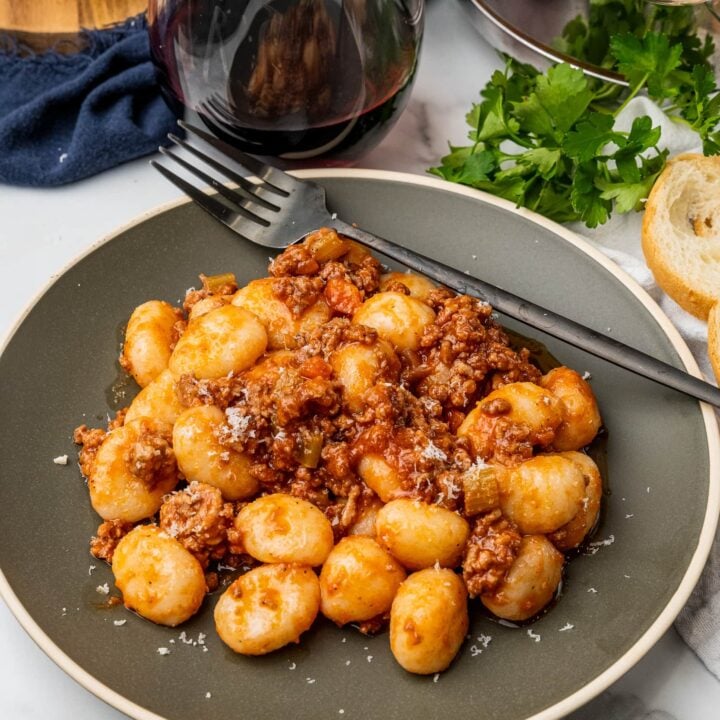
Gnocchi Bolognese
Ingredients
- 1 lb gnocchi
- approx. 1/4 cup (20g) diced carrots
- approx. 1/4 cup (20g) diced celery
- approx. 1/4 cup (20g) diced onion
- 1/2 cup Extra Virgin Olive Oil
- 5 ounces (150 g) ground pork**
- 5 ounces (150 g) ground beef**
- 5 ounces (150 g) ground pork sausage**
- 1/2 cup red wine
- 7-8 ounces (200g) tomato sauce
- salt and pepper to taste
- fresh chopped parsley (for garnish)
Instructions
- Heat olive oil in a large sauce pan on medium heat. Add the carrots, celery, and onion and cook for about 5 minutes until the onions sweat a little and look clear.
- Next add the meat and cook it thoroughly, break it up with a wood spatula as it cooks. After the meat is cooked, add tsp of sea salt. Salt pulls juices out of meat and vegetables, so waiting until it is cooked to add the salt keeps the sauce from getting watery.
- Add the red wine, slowly pouring it in stirring it into the meat.
- Next add the tomato sauce and a pinch more of salt.
- Cook, covered, on a low simmer for 2 or more hours on low heat, stirring occasionally.
- When the Bolognese sauce is done simmering, make the gnocchi according to package directions.
- Serve one cup of gnocchi with 1/3 to 1/2 cup of Bolognese sauce.
- Top with fresh grated Parmigiano-Reggiano and parsley.
Notes
**This works out to be about a pound of meat. You can ask your local grocer to make a meat loaf pack for you. I've also made this sauce with a farmer's blend of beef, pork, and bacon. If you can't find plain ground pork, ground chicken is a good substitute.


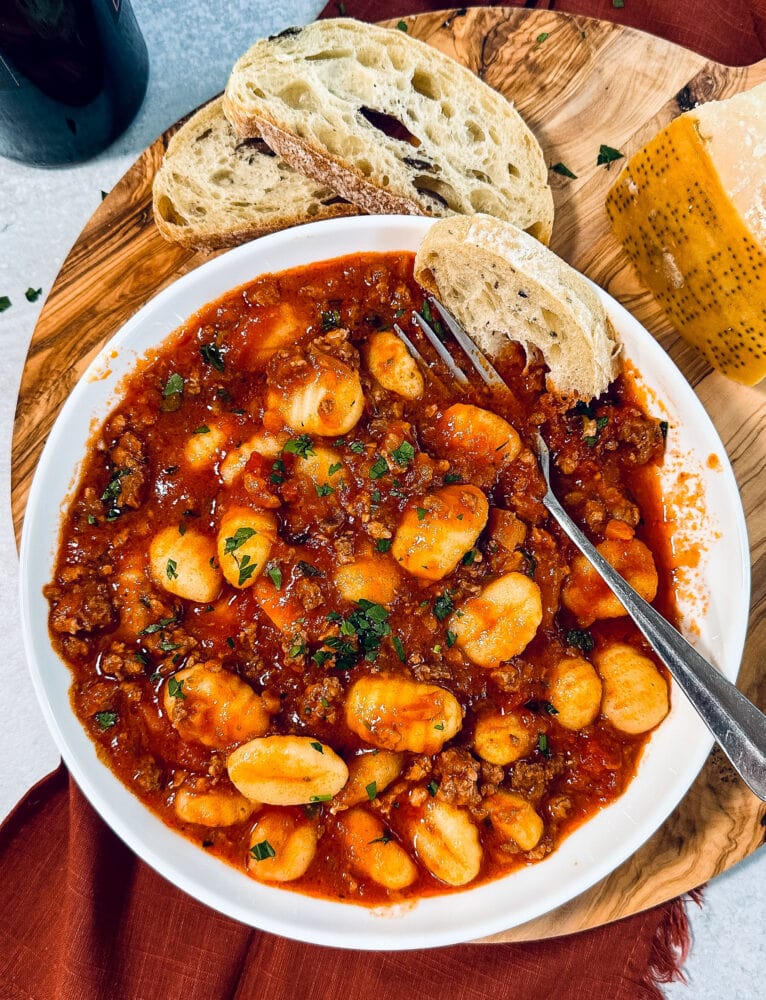
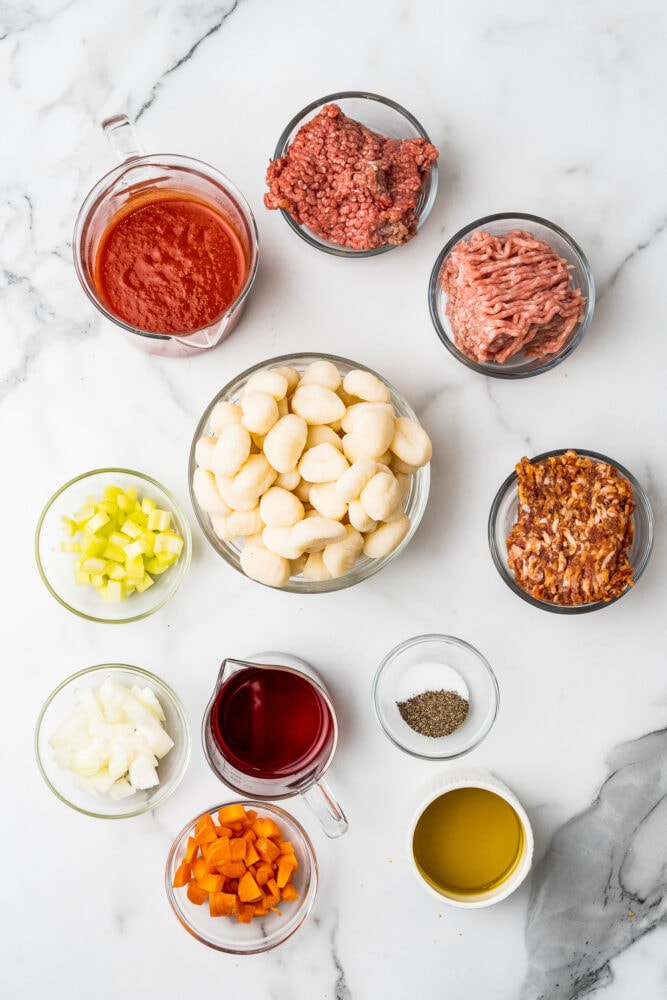
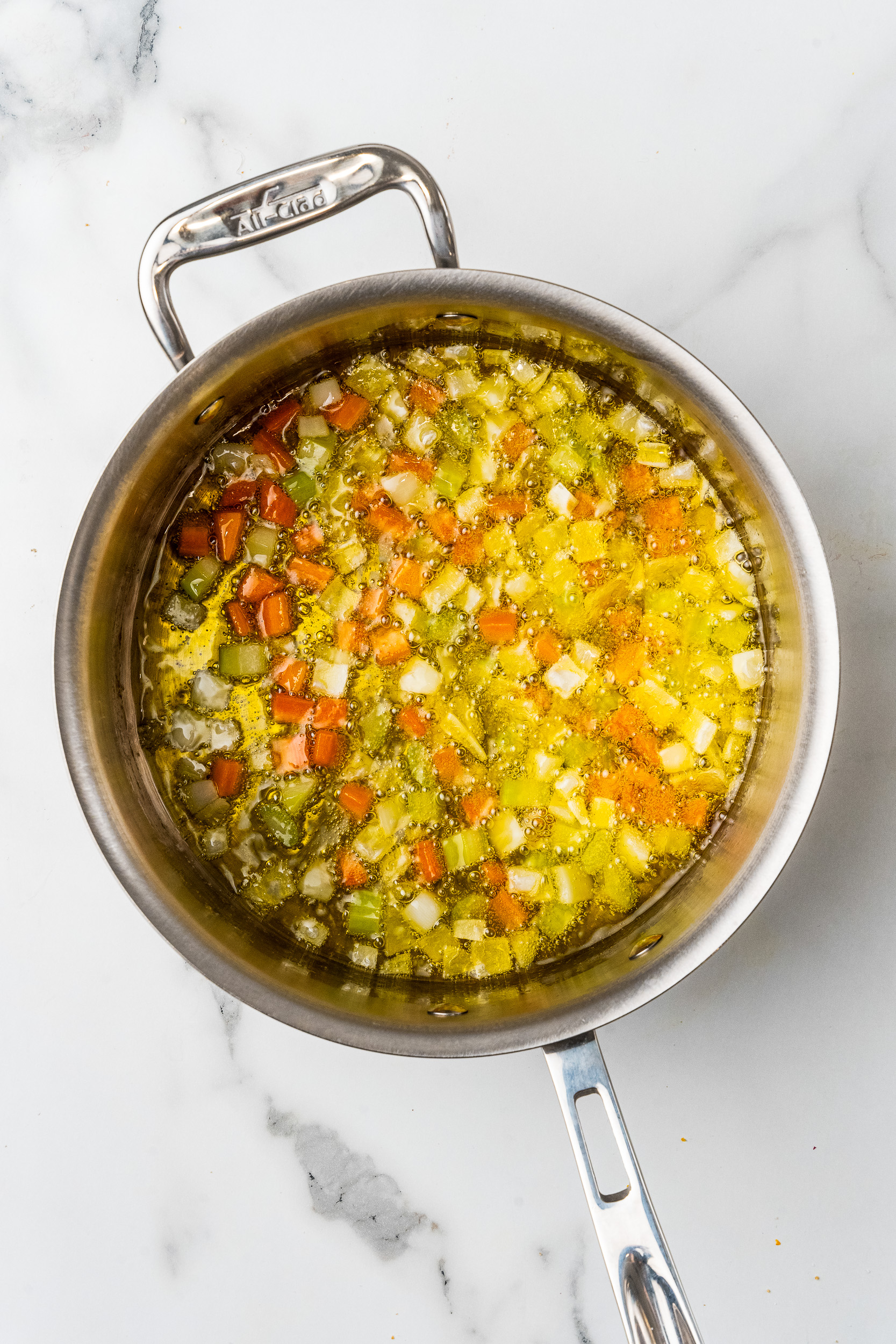
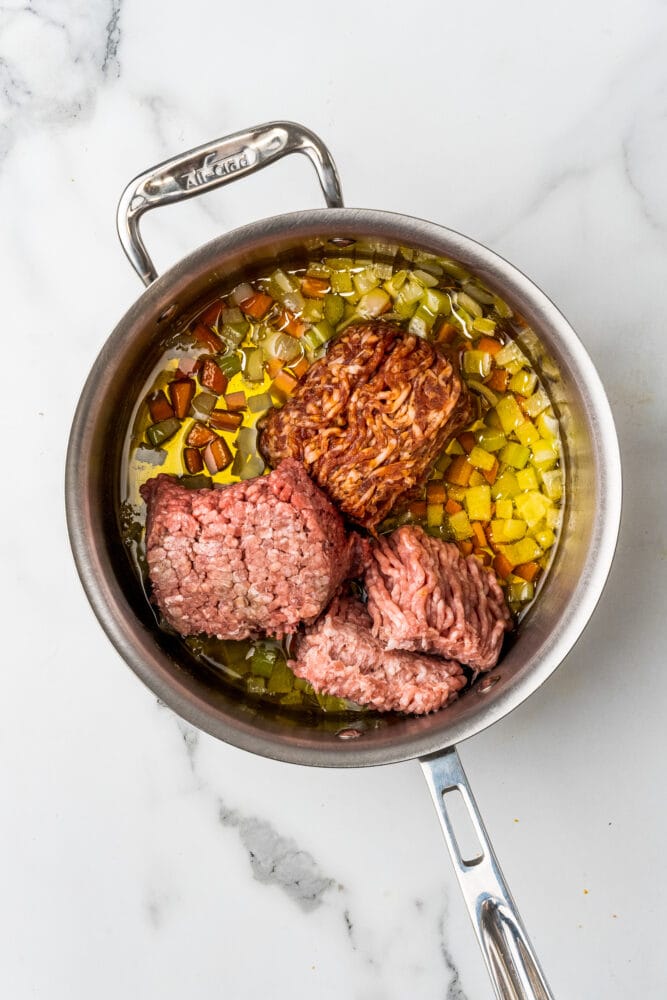
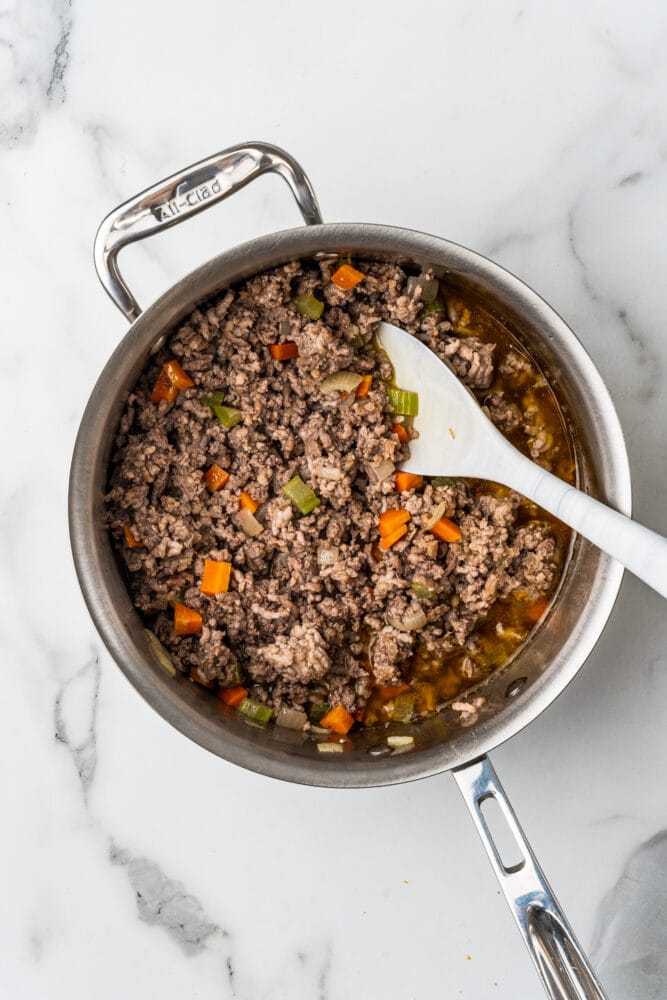
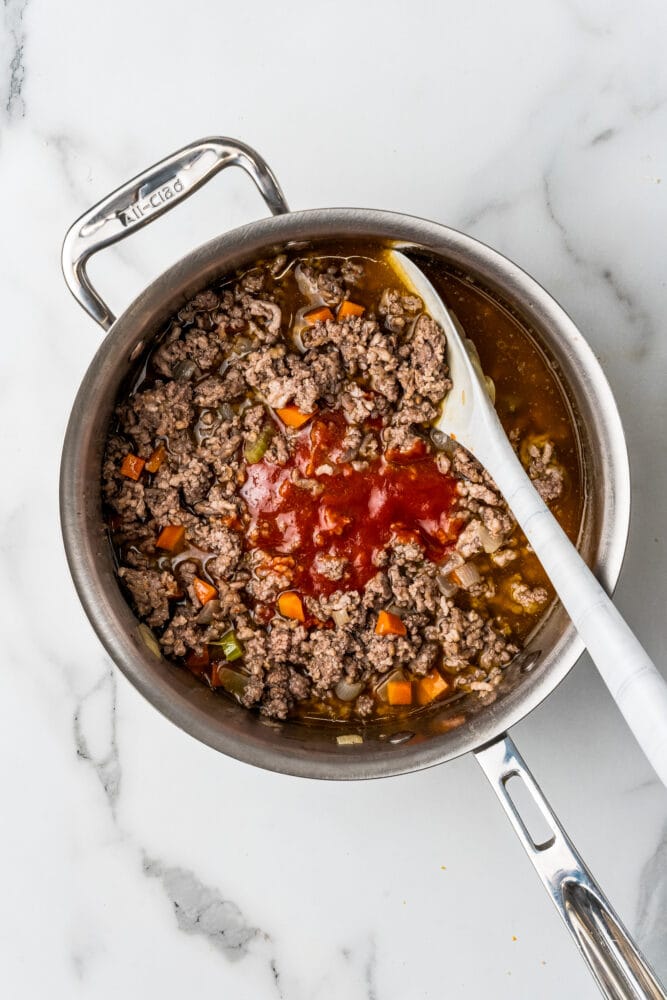
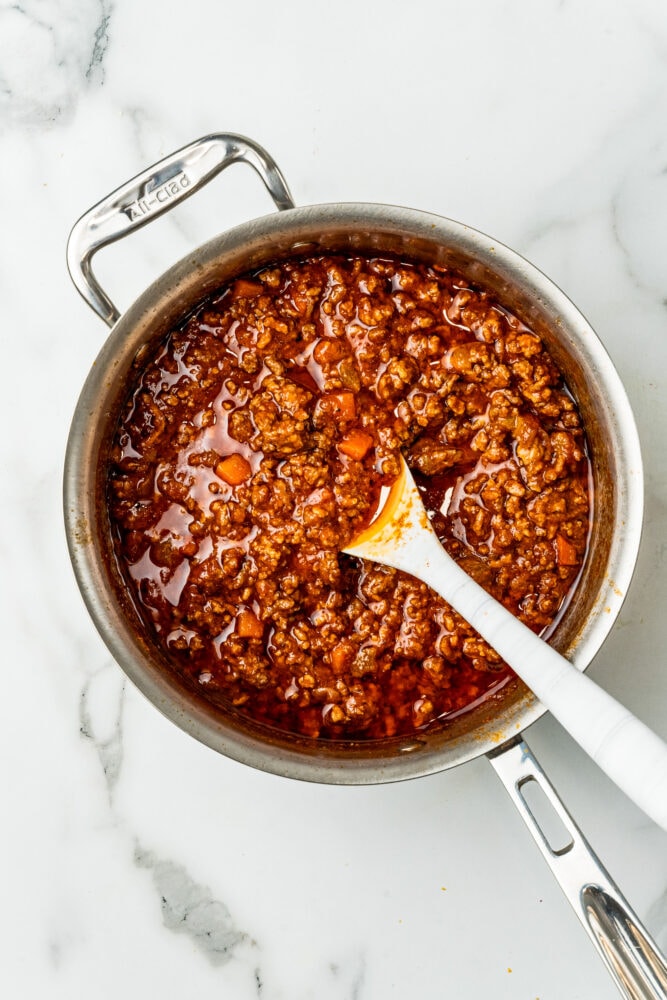
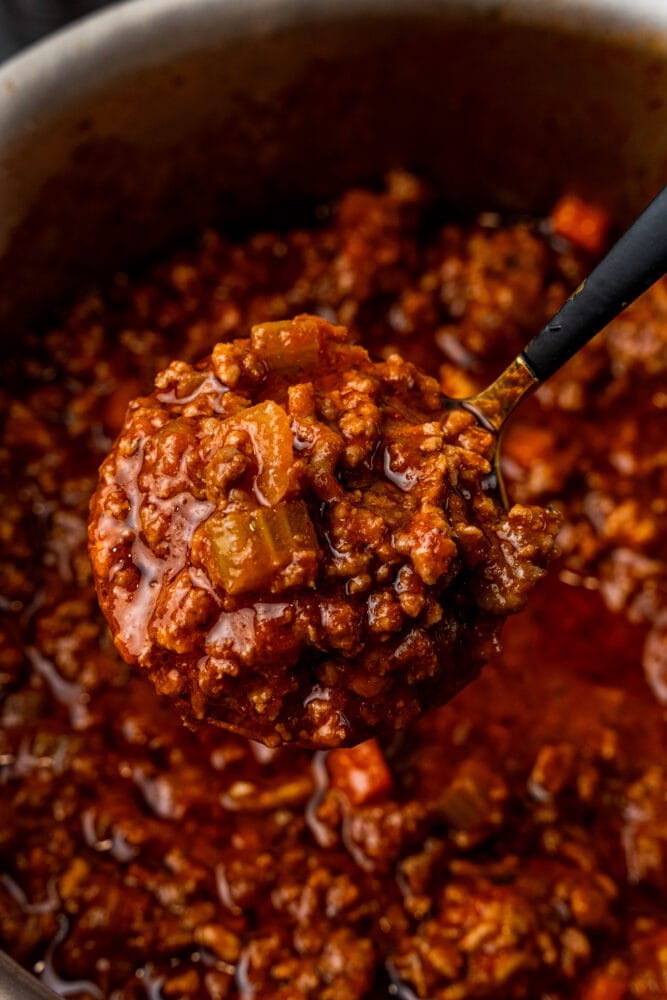
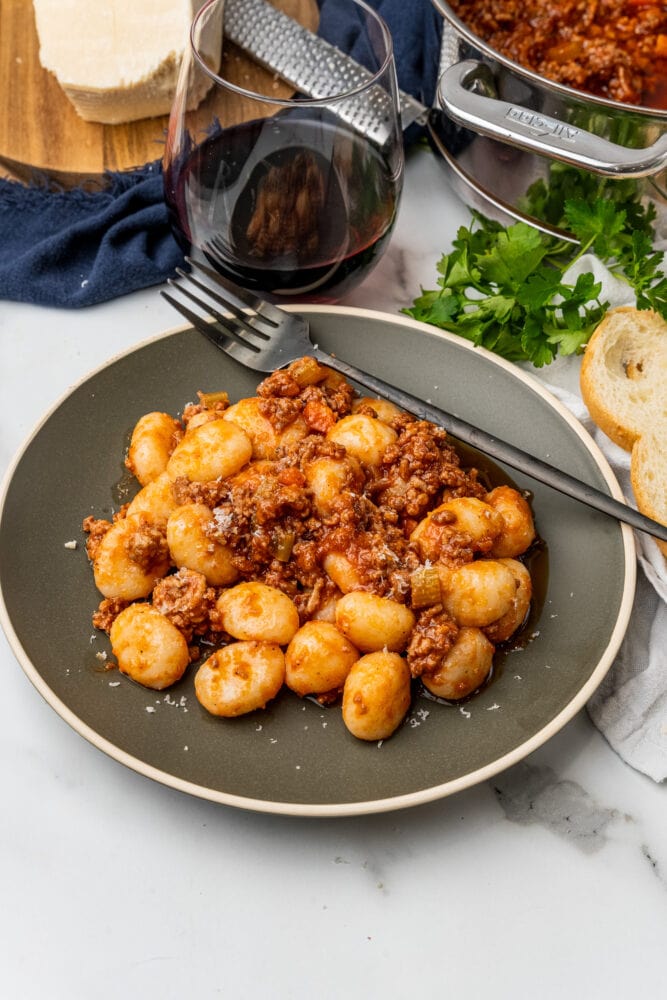
Leave a Reply